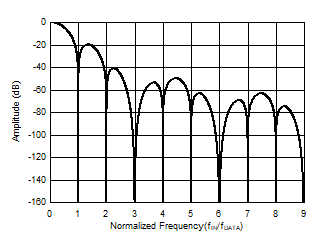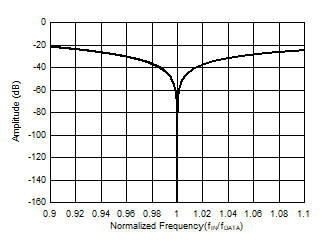SBAS946C April 2021 – September 2022 ADS127L11
PRODUCTION DATA
- 1 Features
- 2 Applications
- 3 Description
- 4 Revision History
- 5 Pin Configuration and Functions
-
6 Specifications
- 6.1 Absolute Maximum Ratings
- 6.2 ESD Ratings
- 6.3 Recommended Operating Conditions
- 6.4 Thermal Information
- 6.5 Electrical Characteristics
- 6.6 Timing Requirements (1.65 V ≤ IOVDD ≤ 2 V)
- 6.7 Switching Characteristics (1.65 V ≤ IOVDD ≤ 2 V)
- 6.8 Timing Requirements (2 V < IOVDD ≤ 5.5 V)
- 6.9 Switching Characteristics (2 V < IOVDD ≤ 5.5 V)
- 6.10 Timing Diagrams
- 6.11 Typical Characteristics
- 7 Parameter Measurement Information
-
8 Detailed Description
- 8.1 Overview
- 8.2 Functional Block Diagram
- 8.3 Feature Description
- 8.4 Device Functional Modes
- 8.5 Programming
- 8.6
Registers
- 8.6.1 DEV_ID Register (Address = 0h) [reset = 00h]
- 8.6.2 REV_ID Register (Address = 1h) [reset = xxh]
- 8.6.3 STATUS Register (Address = 2h) [reset = x1100xxxb]
- 8.6.4 CONTROL Register (Address = 3h) [reset = 00h]
- 8.6.5 MUX Register (Address = 4h) [reset = 00h]
- 8.6.6 CONFIG1 Register (Address = 5h) [reset = 00h]
- 8.6.7 CONFIG2 Register (Address = 6h) [reset = 00h]
- 8.6.8 CONFIG3 Register (Address = 7h) [reset = 00h]
- 8.6.9 CONFIG4 Register (Address = 8h) [reset = 00h]
- 8.6.10 OFFSET2, OFFSET1, OFFSET0 Registers (Addresses = 9h, Ah, Bh) [reset = 00h, 00h, 00h]
- 8.6.11 GAIN2, GAIN1, GAIN0 Registers (Addresses = Ch, Dh, Eh) [reset = 40h, 00h, 00h]
- 8.6.12 CRC Register (Address = Fh) [reset = 00h]
- 9 Application and Implementation
- 10Device and Documentation Support
- 11Mechanical, Packaging, and Orderable Information
Package Options
Mechanical Data (Package|Pins)
Thermal pad, mechanical data (Package|Pins)
- RUK|20
Orderable Information
8.3.5.2.4 Sinc3 + Sinc1 Filter
The sinc3 + sinc1 filter mode is the cascade of the sinc3 and the sinc1 filter. The OSR of the sinc3 stage is fixed (32000) and the OSR of the sinc1 stage is programmable to 3 and 5. Table 8-8 summarizes the characteristics of the sinc3 + sinc1 filter.
Table 8-8 Sinc3 + Sinc1 Filter
Characteristics
| SINC3 OSR | SINC1 OSR | DATA RATE (SPS) | –3-dB FREQUENCY (HZ) | LATENCY (ms) | REJECTION OF FIRST NULL (dB) | |
|---|---|---|---|---|---|---|
| 2% CLOCK TOLERANCE | 6% CLOCK TOLERANCE | |||||
| HIGH-SPEED MODE (fCLK = 25.6 MHz) | ||||||
| 32000 | 3 | 133.3 | 54 | 12.5 | 37 | 26 |
| 32000 | 5 | 80 | 34 | 17.5 | 37 | 26 |
| LOW-SPEED MODE (fCLK = 3.2 MHz) | ||||||
| 32000 | 3 | 16.7 | 6.7 | 100.1 | 34 | 26 |
| 32000 | 5 | 10 | 4.2 | 140.01 | 34 | 26 |
Figure 8-19 shows the frequency response of the sinc3 + sinc1 filter. The frequency response exhibits the characteristic sinc filter response lobes and nulls. The nulls occur at fDATA and at multiples thereof. Figure 8-20 shows the detailed response in the region of 0.9 to 1.1 · fIN / fDATA.
 Figure 8-19 Sinc3 + Sinc1 Frequency
Response
Figure 8-19 Sinc3 + Sinc1 Frequency
Response Figure 8-20 Detail Sinc3 + Sinc1
Frequency Response
Figure 8-20 Detail Sinc3 + Sinc1
Frequency Response